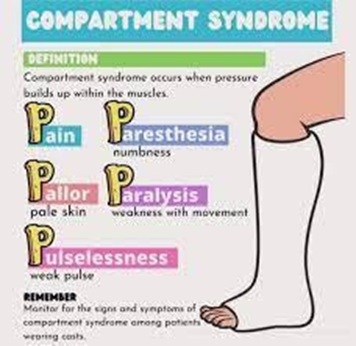In caring for a client with a fracture of the femur, the nurse should be alert for compartment syndrome. What symptom is characteristic of this complication?
Tachycardia and petechiae over the chest wall and buccal membranes.
Positive Homan's sign with calf tenderness and warmth.
acute cough, calm, and decreased blood pressure.
Bulging, Tingling or burning sensation, numbness
The Correct Answer is D
Choice A rationale: Tachycardia and petechiae over the chest wall and buccal membranes are signs of fat embolism syndrome, another complication of fractures that occurs when fat globules enter the bloodstream and obstruct pulmonary vessels.
Choice B rationale: Positive Homan's sign with calf tenderness and warmth are signs of deep vein thrombosis, a condition that can occur after prolonged immobilization or surgery.
Choice C rationale: Acute cough, cyanosis, and decreased blood pressure are signs of pulmonary embolism, a life-threatening condition that occurs when a blood clot travels to the lungs and blocks blood flow.
Choice D rationale: These are signs of compartment syndrome, which is a serious complication of fractures that occurs when increased pressure within a closed space compromises blood flow and tissue perfusion. Compartment syndrome can lead to ischemia, necrosis, and nerve damage if not treated promptly.

Nursing Test Bank
Naxlex Comprehensive Predictor Exams
Related Questions
Correct Answer is C
Explanation
Choice A rationale: Conus medullaris syndrome involves injury or compression to the end portion of the spinal cord and can present with various symptoms but not necessarily lack of normal sympathetic outflow leading to shock.
Choice B rationale: Concussion is a mild traumatic brain injury, and the symptoms described align more with spinal cord injury leading to neurogenic shock.
Choice C rationale: Neurogenic shock occurs due to the loss of sympathetic tone and is characterized by bradycardia, low blood pressure, and vasodilation following spinal cord injury at or above the level of the sixth thoracic vertebra.
Choice D rationale: Diffuse axonal injury typically presents with more widespread brain injury-related symptoms and is not associated with the specific spinal cord-related symptoms described.
Correct Answer is D
Explanation
Choice A rationale: Tachycardia and petechiae over the chest wall and buccal membranes are signs of fat embolism syndrome, another complication of fractures that occurs when fat globules enter the bloodstream and obstruct pulmonary vessels.
Choice B rationale: Positive Homan's sign with calf tenderness and warmth are signs of deep vein thrombosis, a condition that can occur after prolonged immobilization or surgery.
Choice C rationale: Acute cough, cyanosis, and decreased blood pressure are signs of pulmonary embolism, a life-threatening condition that occurs when a blood clot travels to the lungs and blocks blood flow.
Choice D rationale: These are signs of compartment syndrome, which is a serious complication of fractures that occurs when increased pressure within a closed space compromises blood flow and tissue perfusion. Compartment syndrome can lead to ischemia, necrosis, and nerve damage if not treated promptly.

Whether you are a student looking to ace your exams or a practicing nurse seeking to enhance your expertise , our nursing education contents will empower you with the confidence and competence to make a difference in the lives of patients and become a respected leader in the healthcare field.
Visit Naxlex, invest in your future and unlock endless possibilities with our unparalleled nursing education contents today
Report Wrong Answer on the Current Question
Do you disagree with the answer? If yes, what is your expected answer? Explain.
Kindly be descriptive with the issue you are facing.
